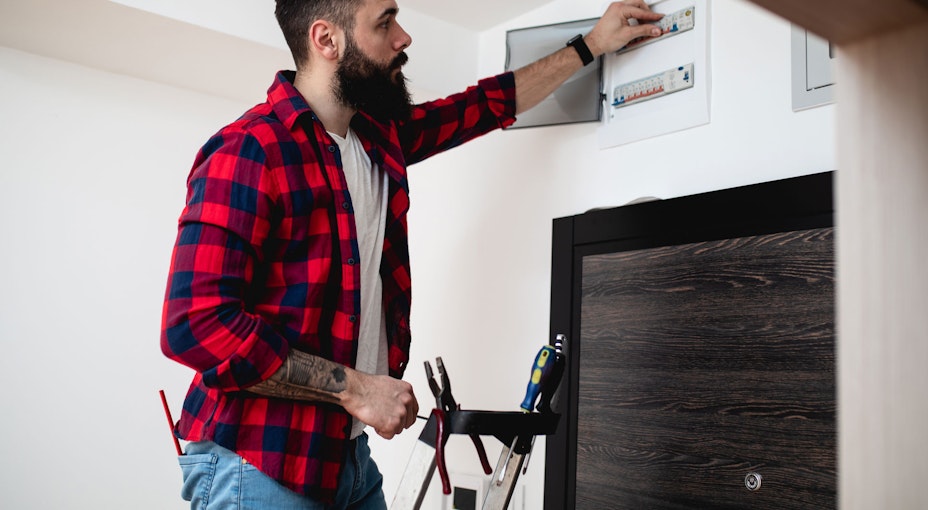Electrical checks for landlords | EICR report guide
By Alan Boswell Group

- What is a landlord Electrical Safety Certificate?
- Is it a legal requirement to have an electrical certificate?
- Who needs to see my EICR?
- What is the purpose of the Electrical Installation Condition Report?
- How many Electrical Installation Condition Reports are there?
- What does an EICR cover?
- What happens if a property fails an EICR?
- Does my property need an EICR?
- What happens if I rent out a property without an EICR?
- How much is an Electrical Installation Condition Report?
- Who can issue the Electrical Installation Certificate?
In this article
- What is a landlord Electrical Safety Certificate?
- Is it a legal requirement to have an electrical certificate?
- Who needs to see my EICR?
- What is the purpose of the Electrical Installation Condition Report?
- How many Electrical Installation Condition Reports are there?
- What does an EICR cover?
- What happens if a property fails an EICR?
- Does my property need an EICR?
- What happens if I rent out a property without an EICR?
- How much is an Electrical Installation Condition Report?
- Who can issue the Electrical Installation Certificate?
For landlords in England and Scotland, it’s a requirement for regular electrical checks to be undertaken at their rental properties. Most often this is done by hiring a professional electrician to inspect your electrical systems and issue an Electrical Installation Condition Report (EICR).In this EICR Report Guide, we look at the electrical safety rules for residential landlords in the UK.
What is a landlord Electrical Safety Certificate?
A landlord electrical safety certificate is an Electrical Installation Condition Report (EICR). Since 1st June 2020, government regulations have made it mandatory for landlords to have the electrics at their property inspected and tested at least once every five years. The inspection and testing must be carried out by a ‘qualified and competent’ person, who then compiles the EICR.
Is it a legal requirement to have an electrical certificate?
Yes, if you are the landlord of privately rented accommodation in England or Scotland, you must ensure the electrical installations at your property meet national standards for electrical safety. A valid EICR is proof of this compliance. If a full installation has been carried out and an Electrical Installation Certificate (EIC) issued, this will serve as proof of compliance for the first five years of the EIC (the certificates are often valid for 10 years or more). Landlords must be aware that if an EIC is issued for work done to only part of the wiring, they must obtain an EICR for the other part of wiring that isn’t covered by the EIC, or the entire wiring system. In Wales, currently only HMOs must have a full electrical inspection every five years. From 15th July 2022, landlords of all properties in Wales must obtain a valid EICR every five years. These regulations do not currently apply to Northern Ireland.
Who needs to see my EICR?
If you have an existing tenant, you need to give them a copy of the EICR within 28 days of the inspection and test. If you have a new tenant, you should send them a copy of the report before they occupy your property. When prospective tenants ask to see your EICR, you should give them a copy within 28 days of the request. Finally, if the relevant local authority asks to see an EICR, you must supply it within 7 days. Local authorities may request to see the report if they have concerns about whether a landlord is complying with the law.
What is the purpose of the Electrical Installation Condition Report?
The purpose of the EICR is to make sure that private rental properties are safe places to live. Over time, electrical installations can deteriorate. For example, insulation can become brittle and unsafe, while sockets and switches can get damaged. For this reason, you need a new EICR at least once every five years.
How many Electrical Installation Condition Reports are there?
There are two main kinds of electrical reports available to landlords. The first is a Periodic Inspection Report (PIR). This is the main EICR which needs to be undertaken at least every five years. A PIR checks the condition of your property’s electrics against the UK standard for the safety of electrical installations, BS 7671. This detailed inspection checks for things like inadequate earthing or bonding, overloaded circuits, shock or fire risks, and defective electrical work. The second type of report is known as a Visual Inspection Report (VIR). This is a visual check of electrical systems in your property. All landlords have a duty of care under the Housing Health & Safety Rating System (HHSRS) to ensure that the electric system is fit for purpose. Although a VIR is not a legal requirement, there could be repercussions if landlords and agents don’t complete a visual inspection and there is a subsequent electrical problem. There is a third type of inspection that many landlords opt for. This is Portable Appliance Testing (PAT). This is carried out by an electrician who tests all ‘plug-in’ appliances at your property, such as toasters, TVs, kettles, computers, and irons. PAT testing is not a legal requirement in England or Wales, but it is compulsory in Scotland for portable electrical equipment provided by the landlord. A PAT test is an excellent way for a landlord, or agent, to ensure all items are safe and fit for purpose.
What does an EICR cover?
As part of a PIR, an electrician tests every circuit in your property and checks for any defects. If there are no defects, you will be issued with an electrical safety certificate. However, if there are defects these will be included in the report. Each fault is assigned to one of the following categories:
Code C1: Danger present. Risk of injury.
Code C2: Potentially dangerous.
Code FI: Further investigation required without delay.
Code C3: Improvement recommended.
If you get a report with codes C1, C2, or FI, then you will need to undertake remedial work before you can be issued with an electrical safety certificate. If a C3 defect is listed, then you don’t have to remedy the problem before the certificate is issued. However, it’s generally sensible to make the recommended improvements sooner rather than later.
What happens if a property fails an EICR?
If your property fails an EICR, you should remedy all the relevant electrical faults within 28 days (or sooner if this is specified in the report). You also need to inform your tenants and local authority that the necessary remedial work has been completed within 28 days.
Does my property need an EICR?
If you are letting out a private rental property in England or Scotland, you must have an EICR. You will need one in Wales from July 2022.That said, there are often tell-tale signs that a property is long overdue an inspection. If you spot any of the following, we strongly recommend you arrange an electrical inspection without delay:
Fixed cables with black rubber insulation
Fixed cables insulated with lead or fabric
An older fuse box with a wooden back or cast-iron switches
Discoloured switches
Sockets in skirting boards
Ceiling fixtures with braided flex
What happens if I rent out a property without an EICR?
If you rent out a property that is legally required to have a valid EICR, you can be fined up to £30,000 by the local authority. Also, if you fail to undertake necessary remedial work, the local authority can (with the tenant’s permission) perform the work itself and bill you for it.
How much is an Electrical Installation Condition Report?
The cost of an EICR depends on the electrician carrying out the inspection and testing and the size of the property. The cheapest EICRs are currently in the region of £80, although fees of approximately £150 are not uncommon.
Who can carry out an EICR?
Electrical inspections must be carried out by someone who is ‘qualified and competent’. In practice, this means hiring an experienced and professional electrician to carry out an EICR. If you can’t demonstrate that an EICR has been conducted by a qualified and competent person, it could also invalidate your insurance.
Can a landlord carry out their own EICR?
If you are a professional electrician, there’s nothing to stop you carrying out your own EICR. Otherwise, you will need to instruct a qualified electrician to complete it on your behalf.
Who can issue the Electrical Installation Certificate?
Should you need to undertake remedial work, you will often need an Electrical Installation Certificate. This is a requirement if you add a new electrical installation, add new circuits to existing ones, change your distribution board or alter a circuit in a way that requires a change to the protective device. The work should be undertaken by an electrician registered for ‘Part P’ of the Building Regulations. They can then issue the certificate. As a landlord, an EICR is, in most cases, one of the documents you must have before you rent out a property. It’s also recommended to arrange annual Visual Inspection Reports for your property, as well as to ask an electrician to undertake PAT testing at the same time. Complying with electrical safety rules is an essential task for every landlord. Not only is the safety of your tenants part of your duty of care, but failing to comply with EICR rules can land you with big fines and could invalidate your landlord insurance. For more information about the other obligations of private landlords, be sure to read our guide to landlord responsibilities.
Legislation and guidance included in this article is correct as of June 2022. Please note that legislation does change, it is always best to check the most up to date guidance on gov.uk. Most landlord insurance policies arranged by Alan Boswell Group also have access to a legal advice helpline where policyholders can seek further advice. EICRs are not regulated by the Financial Conduct Authority.
Need help with your insurance?
Whether you need a quote, have a general enquiry, or want to talk it through over the phone, we're here to help.
Make an enquiry – general and locations
Related guides and insights

A landlord’s guide to property inspections
House and property inspections play a vital role in making sure your property is being maintained. To help you arrange a house inspection and clarify your landlord rights and responsibilities, here’s what to consider.

Do I need landlord insurance?
From buy-to-let portfolio owners to people renting out a room in their home, different kinds of landlords need different types of landlord insurance. In this article we look at some of the common questions that arise when considering landlord insurance.

Energy theft guidance for landlords
The cost-of-living crisis has seen a spike in energy theft. But what should you do if your tenants are illegally abstracting gas or electricity?

Guide to landlord responsibilities
What are the legal responsibilities and obligations of a private landlord? Read our complete guide.
